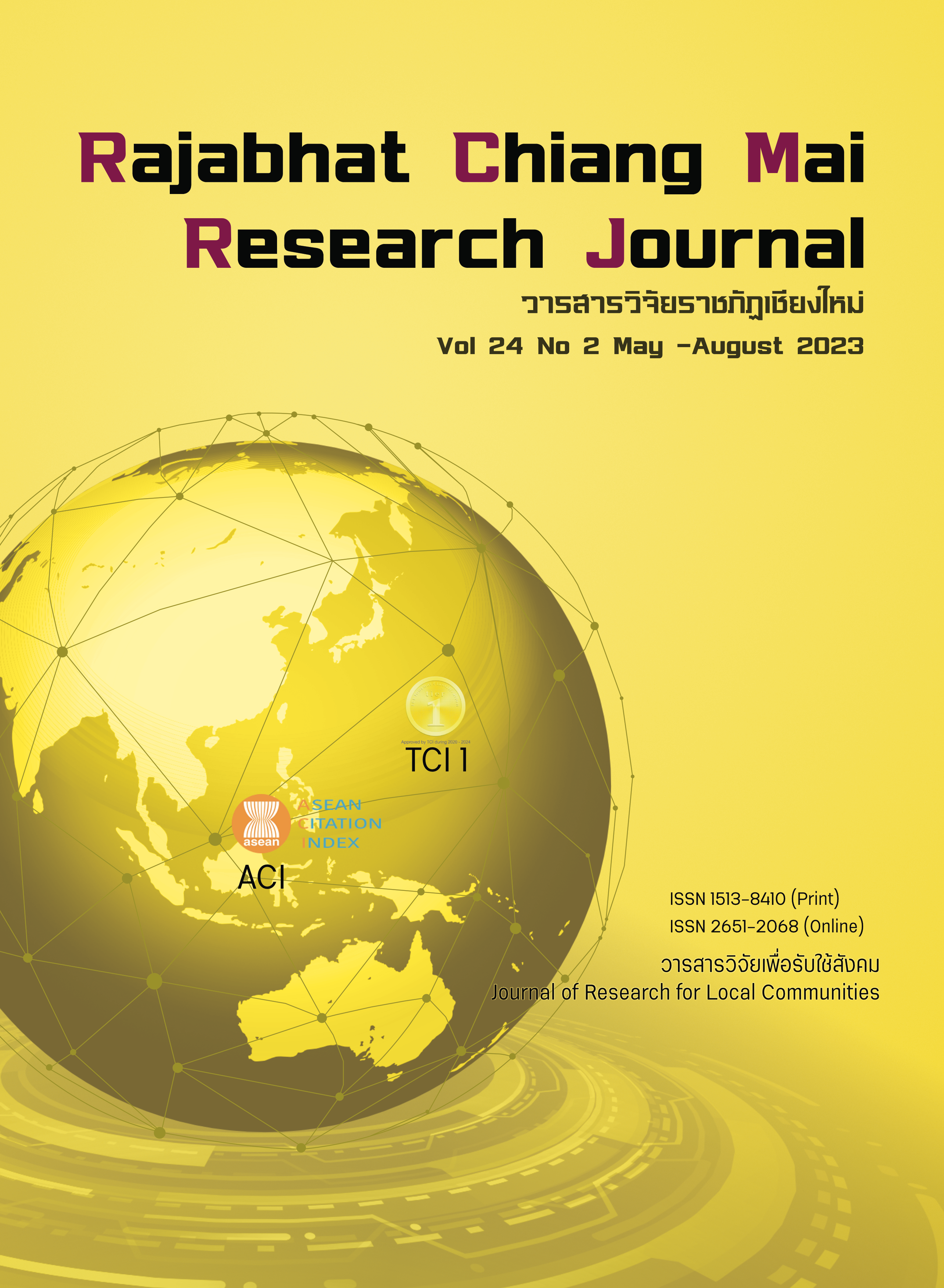Evolution of Economic and Social of “Ruea Nuea” in Khiri Wong Community of Lan Saka District, Nakhon Si Thammarat Province, Thailand
DOI:
https://doi.org/10.57260/rcmrj.2023.263675คำสำคัญ:
Economic evolution, Social evolution, Khiri Wong community, Ruea Nuea, Nakhon Si Thammarat Provinceบทคัดย่อ
This research brought together the issues of economic and social identity of the Khiriwong community with information about the lives of the people in this community to link to the creation of shared values of innovation through the use of the disappearance of the Ruea Nuea over time, wants to highlight the identity and evolution of Ruea Nuea, and tries to present the relationship based on the way of subsistence production in the past through stories that show the importance. This research aims to study the Economic and Social Evolution of “Ruea Nuea” in the Khiri Wong Community of Lan Saka District, Nakhon Si Thammarat Province. This qualitative research included 16 key informants, namely elderly people and village sages who knew about Ruea Nuea in the Khiri Wong Community. This study focuses on participant observation by organizing the group conversation process. It uses structured interviews and opens community forums for data processing and analysis to connect issues. It synthesizes the descriptive analysis and presents the narrative study results of the community. The results showed that the Economic and Social Evolution of Ruea Nuea, consisted of: The era of prosperity in subsistence production. Ruea Nuea was a tool for the occupation with the social and economic lifestyle and the relationship system of people in the Khiriwong community. It is considered a range of "Subsistence production", and living a self-sufficient life. The transition era of marketing relationship production happened in this period. Convenient transportation and connection to the economic progress of the community. “The market system is integrated with the livelihood”, which led to the decline of the ship's role in Ruea Nuea, leading to conservation, and the recession and conservation through traditions and rituals of Ruea Nuea from the old to the new generation in the Kiriwong community. This leads to participation in the conservation of Ruea Nuea. It indicates that Ruea Nuea is important for the coordinating treatment, and create value for the local culture.
Downloads
เอกสารอ้างอิง
Chan, A., & Clegg, S. (2002). History, Culture and Organization Studies. Culture and Organization, 8(4), 259-273. https://doi.org/10.1080/14759550215613
Checkland, S. G. (1959). Theories of Economic and Social Evolution: The Rostow Challenge. Scottish Journal of Political Economy, 6(3), 169-193. https://doi.org/10.1111/j.1467-9485.1959.tb00112.x
Chiang-Aree, W., & Khunram, S. (2012). Nakhon Si, The great wonder of culture and nature. Nature Explorer, 13(145), 26-58. (In Thai)
Dahles, H. (2005). Culture, capitalism and political entrepreneurship: Transnational business ventures of the Singapore‐Chinese in China. Culture and Organization, 11(1), 45-58. https://doi.org/10.1080/14759550500062342
Ferry, K. N., & Joungtrakul, J. (2021). Data Management in Qualitative Research. NRRU Community Research Journal, 15(2), 1-12. https://doi.org/10.14456/nrru-rdi.2021.21
Friedl, J. (1981). The Human Portrait: Introduction to Cultural Anthropology. New Jersey: Prentice-Hall, Inc.
Group of Ruea Nuea in Khiriwong Community. (2013). The way of life, the way of the river, the way of Ruea Nuea. Retrived from https://web.facebook.com/pg/reunheu/about/ ?ref=page_internal (In Thai)
Issarathumnoon, W. (2017). Management of Cultural Landscapes as the Means for Sustainability and Community Resilience Building. NAJUA: Architecture, Design and Built Environment, 32(E-03), 1-27. https://so04.tci-thaijo.org/index.php/NAJUA-Arch/article/view/96514 (In Thai)
Kacerauskas, T., Streimikiene, D., & Bartkute, R. (2021). Environmental Sustainability of Creative Economy: Evidence from a Lithuanian Case Study. Sustainability, 13(17), 9730. https://doi.org/10.3390/su13179730
Kaewthep, K. (1990). Working to develop community culture. Bangkok: Thammasat University. (In Thai)
Kaosol, N. (2018). Thai Local Wisdom and Evolution of Boats. Journal of Chandrakasemsarn, 24(46), 30-45. https://li01.tci-thaijo.org/index.php/crujournal/article/view/130946 (In Thai)
Khaenamkhaew, D., & Muhamad, C. (2021). Ruea Nuea in Khiri Wong: First Cause and Current Changes. Journal of MCU Nakhondhat, 8(9), 227-237. https://so03.tci-thaijo.org/index.php/JMND/article/view/255147/170522. (In Thai)
Kounsamakom, D. (2015). Legal Measure Concerning on Research Ethics in Human. Naresuan University Law Journal, 8(2), 65-88. https://doi.org/10.14456/nulj.2015.13 (In Thai)
Lapatinas, A., Litina, A., & Zanaj, S. (2021). The Impact of Economic Complexity on the Formation of Environmental Culture. Sustainability, 13(2), 870. https://doi.org/10.3390/su13020870
Linstead, S., & Mullarkey, J. (2010). Time, Creativity and Culture: Introducing Bergson. Culture and Organization, 9(1), 3-13. https://doi.org/10.1080/14759550302799
Luan, N. M., Halim, W. P. M. W., & Hafif, A. A. M. (2021). Relationship between Online Interethnic Interactions on Interethnic Bridging Social Capital: A Study of Academic Staff in Malaysian Private Universities. Pertanika Journal of Social Sciences & Humanities, 29(2), 1313-1334. https://doi.org/10.47836/pjssh.29.2.30
Luo, X., Xiong, K., Zhang, J., & Chen, D. (2021). A Study on Optimal Agroforestry Planting Patterns in the Buffer Zone of World Natural Heritage Sites. Sustainability, 13(20), 11544. https://doi.org/10.3390/su132011544
Mammadova, A., & Ivars, J.P. (2018). Learning and Experiencing Traditional Culture and Nature of Kanazawa City to achieve Sustainable Development Goals. European Journal of Sustainable Development, 7(3), 323-333. https://doi.org/10.14207/ejsd.2018.v7n3p323
Mekrueang, K., Khaenamkhaew, D., Dechochai, U., & Damrongwattana, J. (2020). Life of Water ways, Life of land ways: providing services of knowledge of lifefor Ranot community, A case study of Ranot Museum, Ranot Subdistrict, Ranot District, Songkhla Province, Thailand. Journal of Human Society, 10(1), 66-82. https://so03.tcithaijo.org/index.php/humannstru62/article/view/240058 (In Thai)
Mikotajczyk, K. (2021). Sustainable Development of an Individual as a Result of Mutual Enrichment of Professional and Personal Life. Sustainability, 13(2), 697. https://doi.org/10.3390/su13020697
Ministry of Tourism and Sports Thailand. (2021). Source of information: Ban Khiriwong. https://thailandtourismdirectory.go.th (In Thai)
Nicolosi, A., Lagana, R.V., Gregorio, D. D., & Privitera, D. (2021). Social Farming in the Virtuous System of the Circular Economy. An Exploratory Research. Sustainability, 13(2), 989. https://doi.org/10.3390/su13020989
Nithichaianan, N. (2016). Communityeconomic potential at Thai-Cambodian border: A case study of Ban Charokcommunity at Dan sub-district, Kabchoeng district, Surin province. Research and Development Journal, Loei Rajabhat University, 11(Special), 66-75. https://so05.tci-thaijo.org/index.php/researchjournal-lru/article/view/79319 (In Thai)
Panich, V. (2013). The Scholarship of Application Systems Development. Journal of Community Development and Life Quality, 1(1), 1-7. https://so02.tci-thaijo.org/index.php/JCDLQ/article/view/134729 (In Thai)
Pereira, V., & Malik, A. (2015). Making sense and identifying aspects of Indian culture(s) in organizations: Demystifying through empirical evidence. Culture and Organization, 21(5), 355-365. https://doi.org/10.1080/14759551.2015.1082265
Ramitanon, C. (1994). Culture and biodiversity and sustainable development. Bangkok: Local Community Institute. (In Thai)
Ratchabampoeng, S. (2017). Northern boat: Economic and Social Development, Case study of Khiriwong Community, Kamlon Sub-district, Lan Saka District, Nakhon Si Thammarat Province. Nakhon Si Thammarat: Nakhon Si Thammarat Rajabhat University. (In Thai)
Reay, T., Zafar, A., Monteiro, P., & Glaser, V. (2019). Presenting Findings from Qualitative Research: One Size Does Not Fit All. Research in the Sociology of Organizations, 59, 201-216. https://doi.org/10.1108/S0733-558X20190000059011
Ritchie, J., & Lewis, J. (2003). Qualitative Research Practice. London: Sage.
Rond, M. D., & Lok, J. (2013). On the Plasticity of Institutions: Containing and Restoring Practice Breakdowns at the Cambridge University Boat Club. The Academy of Management Journal, 56(1), 185-207. http://dx.doi.org/10.5465/amj.2010.0688
Terzic, A., Bjeljac, Z., Jovicic, A., & Penjisevic, I. (2014). Cultural Route and Ecomuseum Concepts as a Synergy of Nature, Heritage and Community Oriented Sustainable Development Ecomuseum “Ibar Valley” in Serbia. European Journal of Sustainable Development, 3(2), 1-16. https://doi.org/10.14207/ejsd.2014.v3n2p1
Tylor, E. B. (1871). Primtive culture. London, England: Murray Publishers.
Zerihun, M. F. (2021). Agroforestry Practices in Livelihood Improvement in the Eastern Cape Province of South Africa. Sustainability, 13(15), 8477. https://doi.org/10.3390/su13158477
ดาวน์โหลด
เผยแพร่แล้ว
รูปแบบการอ้างอิง
ฉบับ
ประเภทบทความ
สัญญาอนุญาต
ลิขสิทธิ์ (c) 2023 วารสารวิจัยราชภัฏเชียงใหม่

อนุญาตภายใต้เงื่อนไข Creative Commons Attribution-NonCommercial-NoDerivatives 4.0 International License.
1. บทความ ข้อมูล เนื้อหา รูปภาพ ฯลฯ ที่ได้รับการตีพิมพ์ใน “Community and Social Development Journal” ถือเป็นลิขสิทธิ์ของ Community and Social Development Journal มหาวิทยาลัยราชภัฏเชียงใหม่ และเพื่อให้เผยแพร่บทความได้อย่างเหมาะสมผ่านสื่อสิ่งพิมพ์และอิเล็กทรอนิกส์ ผู้เขียนยังคงถือครองลิขสิทธิ์บทความที่ตีพิมพ์ภายใต้ใบอนุญาต Creative Commons Attribution (CC BY) ซึ่งอนุญาตให้เผยแพร่บทความซ้ำในแหล่งอื่นได้ โดยอ้างอิงต้องอ้งอิงบทความในวารสาร ผู้เขียนต้องรับผิดชอบในการขออนุญาตผลิตซ้ำเนื้อหาที่มีลิขสิทธิ์จากแหล่งอื่น
2. เนื้อหาบทความที่ปรากฏในวารสารเป็นความรับผิดชอบของผู้เขียนบทความโดยตรง ซึ่งกองบรรณาธิการวารสารไม่จำเป็นต้องเห็นด้วยหรือร่วมรับผิดชอบใดๆ














